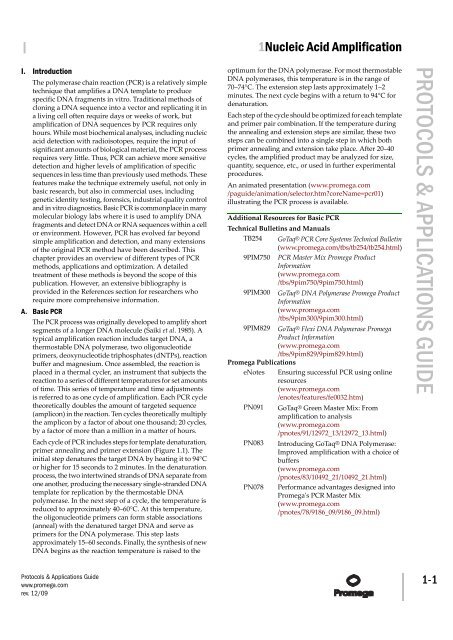Protocols and Applications Guide (US Letter Size) - Promega
Protocols and Applications Guide (US Letter Size) - Promega
Protocols and Applications Guide (US Letter Size) - Promega
You also want an ePaper? Increase the reach of your titles
YUMPU automatically turns print PDFs into web optimized ePapers that Google loves.
| 1Nucleic Acid Amplification<br />
I. Introduction<br />
The polymerase chain reaction (PCR) is a relatively simple<br />
technique that amplifies a DNA template to produce<br />
specific DNA fragments in vitro. Traditional methods of<br />
cloning a DNA sequence into a vector <strong>and</strong> replicating it in<br />
a living cell often require days or weeks of work, but<br />
amplification of DNA sequences by PCR requires only<br />
hours. While most biochemical analyses, including nucleic<br />
acid detection with radioisotopes, require the input of<br />
significant amounts of biological material, the PCR process<br />
requires very little. Thus, PCR can achieve more sensitive<br />
detection <strong>and</strong> higher levels of amplification of specific<br />
sequences in less time than previously used methods. These<br />
features make the technique extremely useful, not only in<br />
basic research, but also in commercial uses, including<br />
genetic identity testing, forensics, industrial quality control<br />
<strong>and</strong> in vitro diagnostics. Basic PCR is commonplace in many<br />
molecular biology labs where it is used to amplify DNA<br />
fragments <strong>and</strong> detect DNA or RNA sequences within a cell<br />
or environment. However, PCR has evolved far beyond<br />
simple amplification <strong>and</strong> detection, <strong>and</strong> many extensions<br />
of the original PCR method have been described. This<br />
chapter provides an overview of different types of PCR<br />
methods, applications <strong>and</strong> optimization. A detailed<br />
treatment of these methods is beyond the scope of this<br />
publication. However, an extensive bibliography is<br />
provided in the References section for researchers who<br />
require more comprehensive information.<br />
A. Basic PCR<br />
The PCR process was originally developed to amplify short<br />
segments of a longer DNA molecule (Saiki et al. 1985). A<br />
typical amplification reaction includes target DNA, a<br />
thermostable DNA polymerase, two oligonucleotide<br />
primers, deoxynucleotide triphosphates (dNTPs), reaction<br />
buffer <strong>and</strong> magnesium. Once assembled, the reaction is<br />
placed in a thermal cycler, an instrument that subjects the<br />
reaction to a series of different temperatures for set amounts<br />
of time. This series of temperature <strong>and</strong> time adjustments<br />
is referred to as one cycle of amplification. Each PCR cycle<br />
theoretically doubles the amount of targeted sequence<br />
(amplicon) in the reaction. Ten cycles theoretically multiply<br />
the amplicon by a factor of about one thous<strong>and</strong>; 20 cycles,<br />
by a factor of more than a million in a matter of hours.<br />
Each cycle of PCR includes steps for template denaturation,<br />
primer annealing <strong>and</strong> primer extension (Figure 1.1). The<br />
initial step denatures the target DNA by heating it to 94°C<br />
or higher for 15 seconds to 2 minutes. In the denaturation<br />
process, the two intertwined str<strong>and</strong>s of DNA separate from<br />
one another, producing the necessary single-str<strong>and</strong>ed DNA<br />
template for replication by the thermostable DNA<br />
polymerase. In the next step of a cycle, the temperature is<br />
reduced to approximately 40–60°C. At this temperature,<br />
the oligonucleotide primers can form stable associations<br />
(anneal) with the denatured target DNA <strong>and</strong> serve as<br />
primers for the DNA polymerase. This step lasts<br />
approximately 15–60 seconds. Finally, the synthesis of new<br />
DNA begins as the reaction temperature is raised to the<br />
<strong>Protocols</strong> & <strong>Applications</strong> <strong>Guide</strong><br />
www.promega.com<br />
rev. 12/09<br />
optimum for the DNA polymerase. For most thermostable<br />
DNA polymerases, this temperature is in the range of<br />
70–74°C. The extension step lasts approximately 1–2<br />
minutes. The next cycle begins with a return to 94°C for<br />
denaturation.<br />
Each step of the cycle should be optimized for each template<br />
<strong>and</strong> primer pair combination. If the temperature during<br />
the annealing <strong>and</strong> extension steps are similar, these two<br />
steps can be combined into a single step in which both<br />
primer annealing <strong>and</strong> extension take place. After 20–40<br />
cycles, the amplified product may be analyzed for size,<br />
quantity, sequence, etc., or used in further experimental<br />
procedures.<br />
An animated presentation (www.promega.com<br />
/paguide/animation/selector.htm?coreName=pcr01)<br />
illustrating the PCR process is available.<br />
Additional Resources for Basic PCR<br />
Technical Bulletins <strong>and</strong> Manuals<br />
TB254 GoTaq® PCR Core Systems Technical Bulletin<br />
(www.promega.com/tbs/tb254/tb254.html)<br />
9PIM750 PCR Master Mix <strong>Promega</strong> Product<br />
Information<br />
(www.promega.com<br />
/tbs/9pim750/9pim750.html)<br />
9PIM300 GoTaq® DNA Polymerase <strong>Promega</strong> Product<br />
Information<br />
(www.promega.com<br />
/tbs/9pim300/9pim300.html)<br />
9PIM829 GoTaq® Flexi DNA Polymerase <strong>Promega</strong><br />
Product Information<br />
(www.promega.com<br />
/tbs/9pim829/9pim829.html)<br />
<strong>Promega</strong> Publications<br />
eNotes Ensuring successful PCR using online<br />
resources<br />
(www.promega.com<br />
/enotes/features/fe0032.htm)<br />
PN091 GoTaq® Green Master Mix: From<br />
amplification to analysis<br />
(www.promega.com<br />
/pnotes/91/12972_13/12972_13.html)<br />
PN083 Introducing GoTaq® DNA Polymerase:<br />
Improved amplification with a choice of<br />
buffers<br />
(www.promega.com<br />
/pnotes/83/10492_21/10492_21.html)<br />
PN078 Performance advantages designed into<br />
<strong>Promega</strong>'s PCR Master Mix<br />
(www.promega.com<br />
/pnotes/78/9186_09/9186_09.html)<br />
PROTOCOLS & APPLICATIONS GUIDE 1-1
















